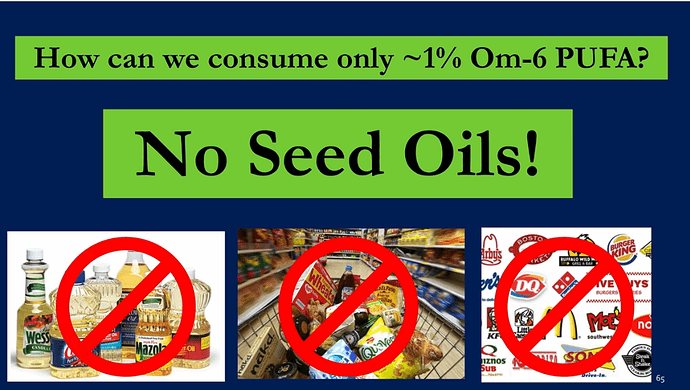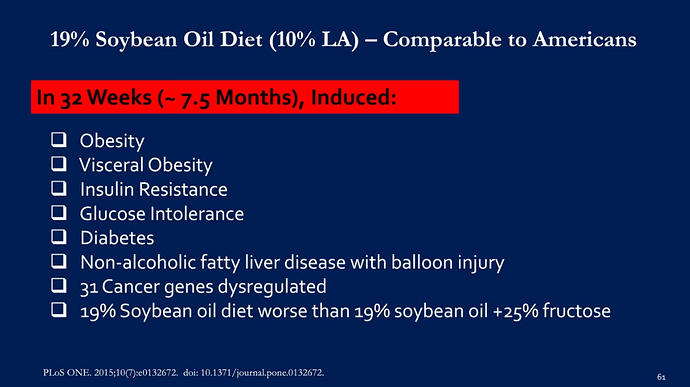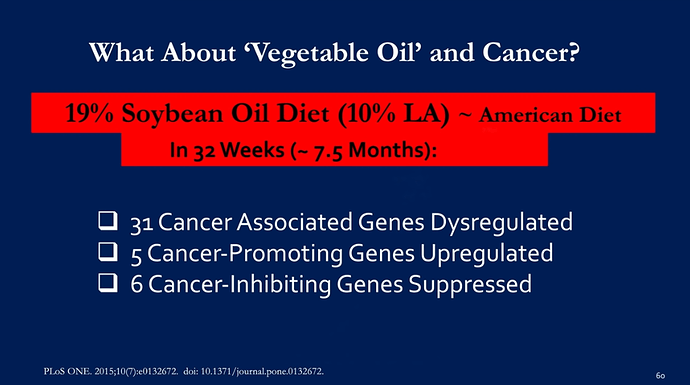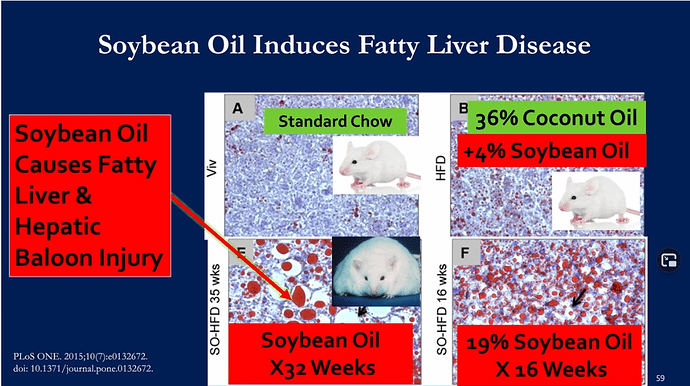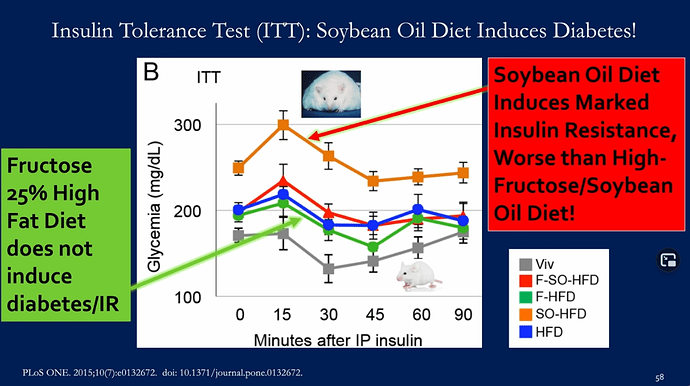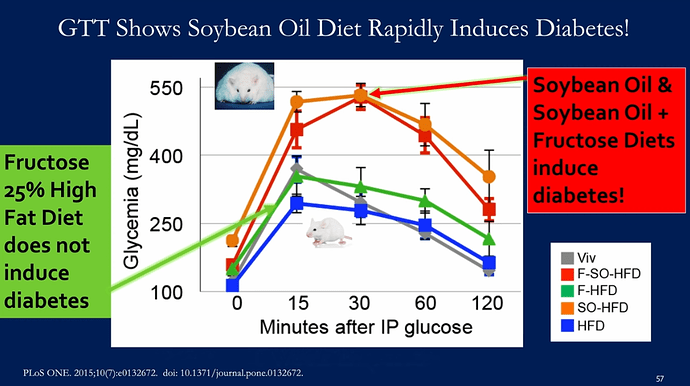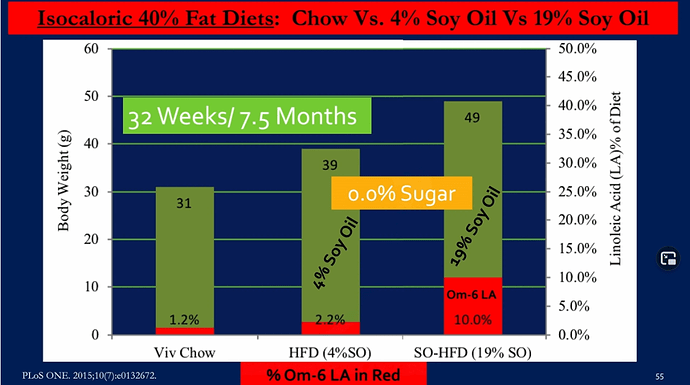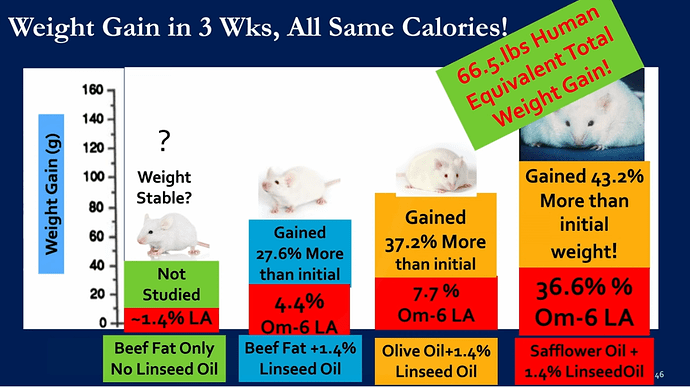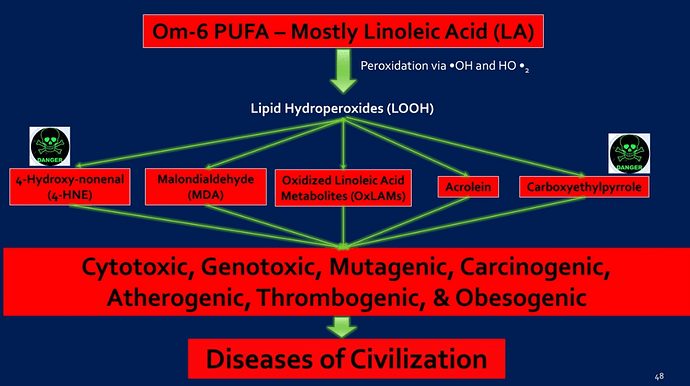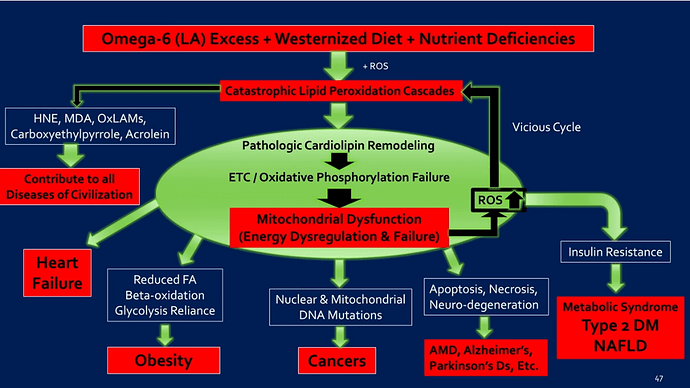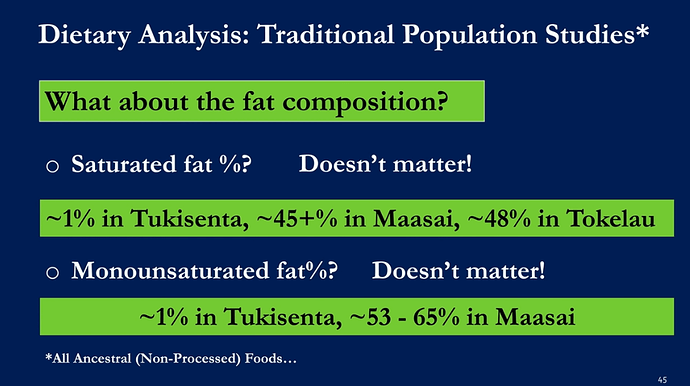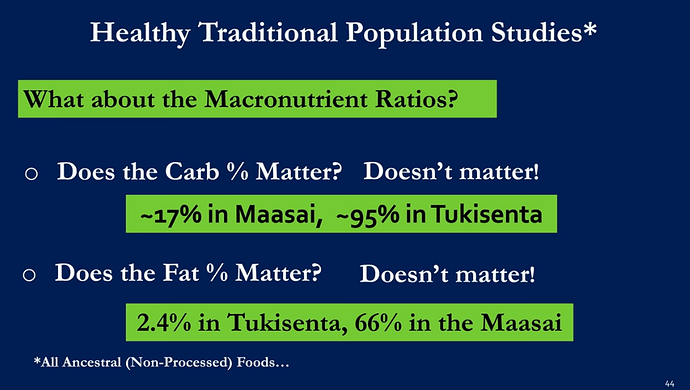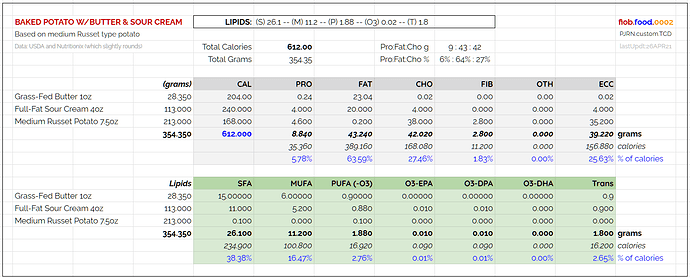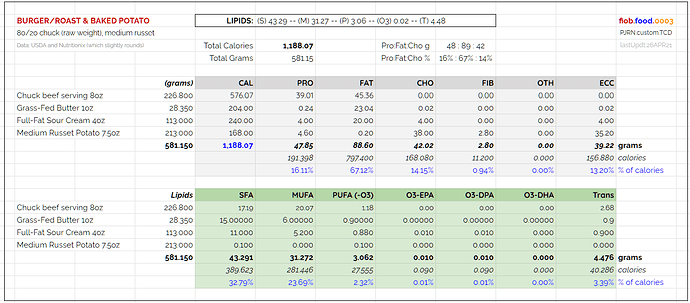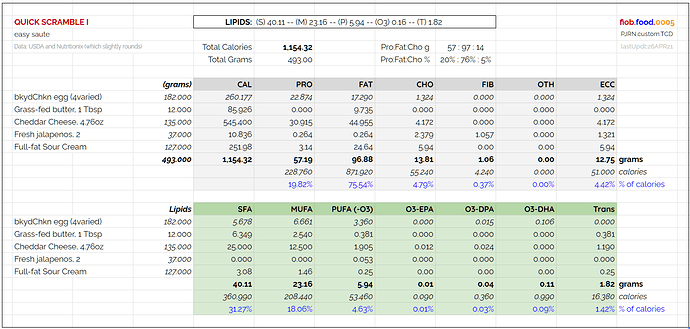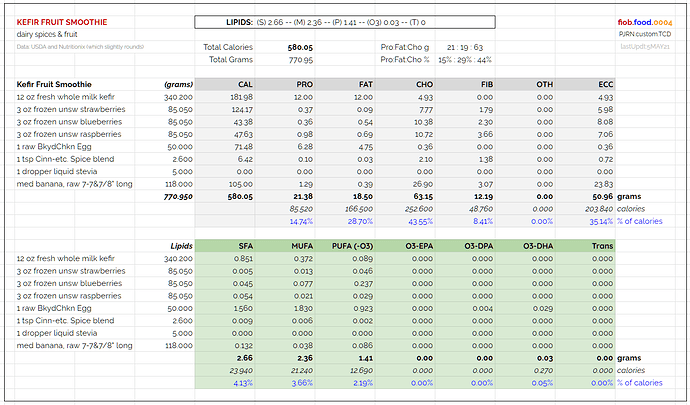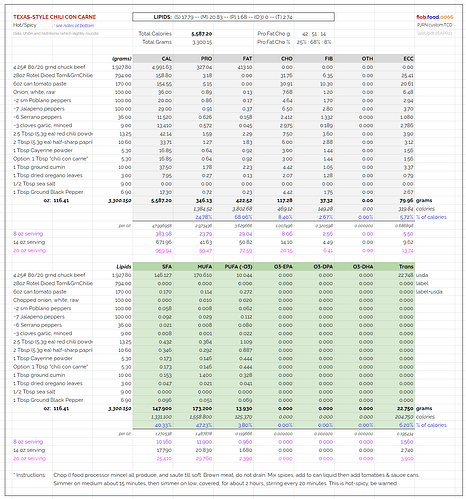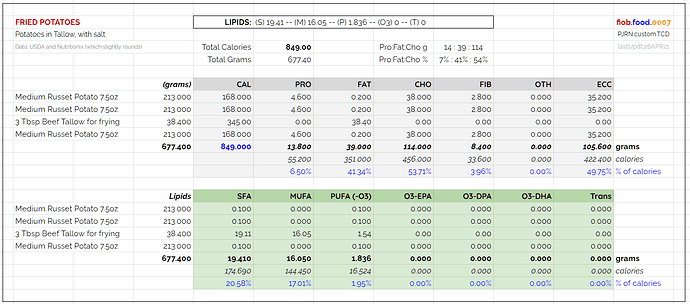Even saturated fats liquefy at cooking temperatures. Polyunsaturates are liquid at room temperature, while saturated and monounsaturated fats are solid. If you call butter art room temperature solid, that is. It has to do with how the molecules line up, or don’t. Basically, oils are liquid at room temperature because of the high percentage of polyunsaturated fats they contain, while the cooking fats we aren’t supposed to eat are roughly equal in saturated and monounsaturated fats, with a small percentage of polyunsaturates.
Fire in a Bottle II, lipedema, adipaging, twinkie-fat
They are also fats that we have evolved to handle. The concern is not only the excess of PUFA’s from plant sources, but that those PUFA’s were not in the human diet before roughly 1860, when cottonseed oil started to be used in the food supply, originally to adulterate butter. Another concern is the compounds these new PUFA’s form when heated to cooking temperatures. Not to mention what all these new chemicals do to the human body when incorporated into cell walls, etc.
I believe this is the source of Lipedema.
I thought that after all the reading I could do ~8 years ago, but now that there is more info I’ve seen public about PUFA, it seems even more certain.
It’s a ‘no cure known’ so if Brad’s theory works… gradually… to shift the %/ratio of PUFA stored in fat… which would secondarily I assume eventually affect membranes though it might be awhile following… it would be the only thing known to touch it.
Dr. Lustig talks about some of this in this video of his that I just came across:
That was a very good video but that particular one didn’t actually talk about the fats being absorbed into cell membranes.
It did however scare me straight about sugar LOL
Interesting his notes about how when they fed people starch instead of sugar everything improved so much so fast. Well maybe that’s what you meant, I just realized – the thread in general – starch.
three quotes that grabbed my attention from him:
branch chain amino acids from corn-fed beef also causes that [fatty liver from alcohol/sugar]
– Dr. Robert Lustig…they had non-alcoholic pancreas disease too…
– Dr. Robert LustigIf you don’t feed your microbiome, your microbiome will feed on you.
– Dr. Robert Lustig
Lustig continually says ‘sugar’ when he means ‘fructose’. I found it a bit confusing to keep that in mind as he kept saying one or the other. To me ‘sugar’ means ‘carb’. Anyway in another topic I mentioned that fructose serves no useful purpose and this video confirms that statement in spades. Thanks.
PS: He also condemns all ‘processed food’ as bad because of added ‘sugar’. I think that’s painting with too broad a brush. I eat processed food that contains no added ‘sugar’/fructose/HFCS, including many cheeses, canned meats and fish, sliced roast beef. Also, I don’t understand his argument about so-called ‘corn-fed’ beef. If according to his presentation the damage is in the liver, then it seems more like an argument to avoid eating beef liver. All cattle spend most of their lives eating grass and hay. It’s only the final ‘finish’ when they’re fed grain to add the fat we keto folks love so much.
Oh, yes. This talk by Dr. Chris Knobbe discusses that:
https://www.youtube.com/watch?v=7kGnfXXIKZM
I believe that whenever he says “sugar” he is talking about the chemical called “table sugar” or “sucrose,” which is a glucose molecule linked to a fructose molecule. He is definitely not talking about serum glucose. If that’s what he’s talking about, that’s what he calls it.
Most processed foods found in the center aisles of the supermarket have been produced with much of the fat removed, hence sugar (sucrose) and salt have been added to improve the flavour. He is not talking about the minimally-processed foods you mention, and I don’t know anyone who would call slicing roast beef “processing” it. Perhaps he should say “manufactured” instead of “processed.” I’m more or less with him on this one, because I don’t consider cheese or sausage to be “processed” foods. And things may be better in Canada, but in the U.S. you would need to check the list of ingredients carefully to make sure that no sugar of any type has been sneaked into your sausage.
As for his point about “corn-fed” beef, I believe it is simply that grass-finished beef has a better ω-3/ω-6 ratio. If you prefer corn-finished beef, there is nothing to stop you from eating it. I personally don’t enjoy the taste of the “grass-fed” beef I’ve purchased, and it’s too expensive to buy regularly, so I don’t worry about it.
That was a nice video, it was all about fats – although it wasn’t about incorporation into the cell membrane, merely that we store them and some are toxic.
I grabbed some screenshots during that I found worthy I will post here.
The most interesting by far and that almost nobody wants to think about it seems – but I see someone mention this now and then, like the Hans guy from South Africa I mentioned previously – is that weirdly, fructose actually seems to be a bit protective in some instances. We look at it like absolutely the devil but maybe this is like looking at SFA that way, when someone is in a pathologic state, things that may not be harmful (in dose-dependent fashion of course) normally can be.
I watched a super brief video last night and got hooked and ended up spending too much of my night and then morning watching more video by this guy. He is a blood test freak and he’s been tracking his food in detail and testing constantly for many years, and so has been able to get a N=1 look into what changes in his body. Some of this doesn’t have much research yet I think, and being just one person it’s only suggestive of course, but I find it very interesting.
https://www.youtube.com/channel/UCT1UMLpZ_CrQ_8I431K0b-g
When he added yogurt to his daily diet there was some very interesting improvements. A number of things I’ve seen recently suggest that kefir, yogurt, and fermented produce, are just really good effects in the body.
Fructose is a lot like ethanol. Neither is useful nor needed. They’re both processed in the same liver pathways, result in a lot of the same metabolites, and in small doses seem/might have some beneficial effects (Note: the jury is still out on this!). In more than small doses both do the same damage to the liver and eventually destroy it. Game over. Everyone’s mileage varies as to what constitutes ‘small doses’ and exactly where the damage begins. Both have done a lot of damage to a lot of people. In a lot of ways both are also similar to an addictive drug that requires bigger and bigger doses to get the desired high. They’re so similar I think a good argument could be made that they represent a 4th macro. They’re both consumed as if they are a macro. Just my humble opinion. 
Yeah I think since sugar basically becomes alcohol in the body the way it’s digested, sugar/alcohol should be the 4th macro… and you’re right the quantities ingested are high enough to make that make sense.
I do notice though that the body has a pretty brilliant way of dealing with nearly everything. Even slightly toxic things it often uses to its advantage in some ways.
It’s just the quantity that seems to be out of control. And the main reason for that is because
a/ PUFA is our main fat and it does not serve us for energy really, and
b/ we’re not eating enough good stuff, so we stuff the bad stuff into the appetite needs.
Eat sufficient meat and dairy and one doesn’t have room for a lot else. Whatever else someone ate in that case is not likely to be in quantities large enough to do that much harm, and it’s possible that harm is mitigated by other factors (including diverse micronutrients).
I was thinking this morning about a number of island peoples who lived on coconuts and boar and pineapple and they did not become gigantic as a norm until the more recent days. As some of those slides I posted showed, there are dietary patterns in people who ate a ton of starch or a ton of fructose and were healthy, but the one thing consistent in every healthy group is a super low intake of PUFA (and much of it being Omega 3 when it was even slightly higher).
I’m trying to work out stuff to eat for this, including carbs which I want to equal whatever I’ll do on S&S as I call it, so any water gain showing up on scale is not a confounding factor.
So far I’m just eating, trying to ignore carbs and eat a variety of things now’s my chance, whole foods I mean like produce, and then after the fact I will work out the macros.
Do you know how hard it is to stay even below 4% PUFA? And most the healthy peoples studied were lower than that, some a lot lower.
I almost have to pile on calories on purpose in fats like dairy, just so that the PUFA % will be lower in the overall meal. It’s ridiculous.
Here is a simple 8oz bit of burger patty or roast.
(edited the above for copy error 5/5/2021 6:21pm CDT)
A baked potato with butter and sour cream
combining them
(edited the above for copy error 5/5/2021 6:21pm CDT)
A dairy-fat scramble, enough to stay full for the day, nearing 5%
Yeah that’s all I have so far. I mean I have some other things but they are just my typical lowcarb foods, or they are higher carb stuff. Like this morning I had fresh kefir, a blend of strawberry raspberry blueberries frozen, a banana, a raw backyard-chicken egg, a teaspoon of spice blend (cinnamon nutmeg ginger allspice cloves), one dropper liquid stevia, blended. Super delicious. I’ve so rarely eaten carbs outside holidays for years it seems super novel. (I also had a protein drink.)
It’s not about the upcoming eating plan though… it’s not really rigid, it’s just up SFA as much as poss, lower PUFA as much as poss, take some supps/efforts to send SCD1 down and PPAR-alpha/AMPK up. That’s more a concept recipe, the detail of the formula is up to the individual. Fructose is the devil, do I dare eat berries let alone a banana with my kefir, I’m big on healing my gut, increasing my metabolism, and expanding my micronutrients, and it fits into that part. As far as S&S goes, it’s basically “fermented whole milk to which I added fructose.” 
I thought I was obsessive about tracking nutrients! 
My thoughts on PUFAs: if it’s coming from food, especially animal foods rather than plants it’s likely just fine and in proportion to what we need to be eating. Chickens and/or pigs are dicey since they may have been fed a diet high in seed oils. Our Pleistocene ancestors ate PUFAs since there’s small amounts in just about everything they ate. They did just fine.
I think the problems with PUFAs derive from concentrating them in seed oils, which only began in the late 19th century with the invention of linseed/cottonseed oil to make a buck off the residue from cotton processing. Then in the mid-20th century folks discovered they could extract an ersatz ‘oil’ from a number of seeds by subjecting them to enough pressure, heat and solvents. This stuff is really just machine oil and lubricants - not food.
Voila! Heart Healthy! Vegetable Oils! to replace all those artery clogging saturated fats.
That’s my “anything worth doing is worth overdoing” mentality. Either that or I’m still compensating for the Graph Envy™ Karim inspires in me.
No but really, I have spreadsheets with years of nutrition info collection, and it turns out every damn thing I consider I have to go find all over again to find the fats! Because I only collected the macros before, not the fat types. Gaahhhhh
PS oh and did I mention there is NO info on a crapload of things for the fat type details… and the USDA’s “improvement” of their system, well, I liked it a lot better before they fixed what wasn’t broken IMO
Agreed. It’s just that the point of the starch&stearic approach is kind of to heavily overcompensate for a lifetime of this and a body filled with PUFA fats (which reminds me I’m sending in the blood test for the omegaquant.com so I have a baseline starting point to compare to in a few months to see if there is any change).
There’s only so much I can do though. Take up living on cocoa butter perhaps. I actually react ever so slightly to that but have never had it alone only with other things in it as sweet fat bombs so I’m not sure if it’s that I’m reacting to, guess I’ll find out soon. I have no desire to taste savory foods fried in cocoa butter blend oil but I guess we will see what it’s like.
Many years ago a nun told me that anything worth doing was worth doing fanatically. 
My morning smoothie. So far I’m mostly just eating stuff, counting the weight, then later, figuring out the detail, and if needed, fussing with the plan to make it better suited. This one as-is came out better than I expected. Separately I also had a Premiere Protein drink.
I guess I could in theory add a little something like sour cream to it, upping the calories and fats and reducing the pufa% slightly.
Revised 2 of the first grids for a copy error, oops.
Finally finished the ‘paperwork’ on the chili I made last week.
I make this every other week and make 7-12 servings.
Put in freezer and fridge and nuke it when I want it.
Chili con carne is basically my primary lowcarb food group.
If anyone should want to use the recipe be warned it’s pretty spicy.
This is a ridiculous meal but I ate it recently. Meant to have meat too but got busy and forgot then it was too late and I wasn’t hungry and I’d had a lot of protein that day already. Delicious but carby. Waiting for the insulin monster to kick my ass with one of these meals eventually. We’ll see.
…
…
I can’t reply again so adding to last post.  I’ve been taking notes from skim-reading for the last couple weeks and I’m going to be pasting a few in. Most are actually various comments or answers from Brad of FIOB I’ve seen in various places, though not all.
I’ve been taking notes from skim-reading for the last couple weeks and I’m going to be pasting a few in. Most are actually various comments or answers from Brad of FIOB I’ve seen in various places, though not all.
(Vit D and O3 lower SCD1 which we’re trying to lower as it converts stuff to pufa)
Berberine lowers SCD1. As does metformin. As does sterculia oil.
In the Banana Milkshake study, subjects were given Stearic Acid, and that alone was enough to cause mitochondrial fusing and uncoupling - which would gobble-up unsaturated fats in the process.
If Stearic Acid can promote uncoupling at a faster rate than SCD1 can de-saturate our dietary and circulating fat, then it might be the more powerful tool.
Linoleic acid is in EVERYTHINGGGG ughh
Not a problem if you like beef. Beef bacon is just as good as regular bacon, if not better. A few eggs a day shouldn’t be a big deal, especially if every other part of your diet is on point. Burgers, steaks, beef ribs, beef tacos, home made pizzas… everything cooked in butter, tallow, cocoa butter, pure stearic acid…whatever.
we’re unclear about palmitic acid. It seems similar to stearic, but we don’t know if it has the same metabolic effects.
No need to do the starch part. My diet is essentially beef/eggs/cheese, I just toss supplementary stearic in and consciously avoid PUFAs when I stray from my regular foods.
Benefits have been greater carb tolerance (when I do stray from diet) and a bit of mild body recomposition. (A bit less body fat, but more of a reduction in size/location/consistency.) No weight loss to speak of, but also none of the seasonal weight gain I usually experience. And I didnt experience long term appetite reduction until I started doing SCD1 reduction. (i.e. Actively stopping my own biochemistry from desaturating the SFA I consume.)
I chose naringin as one of my scd1 inhibitors, partly because I read that berberine can destroy gut bacteria when taken regularly. I’m hoping naringin has enough of the active/effective ingredient of grapefruit to make a difference (without the citric acid).
“The body requires iodine to metabolize both omega-3 and omega-6 fatty acids”
I have also made an egg sauce using egg yolks, butter, and shredded cheddar cheese. This is freaking delicious - and it’s pretty simple to make.
Sauteed mushrooms in butter is also very good. I’m not sure how much butter gets soaked up - but if you want something else to go with your meat, this is great.
You can saute mushrooms with zucchini in butter or tallow and they will rock your tastebuds.
I use mashed veg, e.g. cauliflower, celeriac, broccoli, or stir-fried shredded things, such as pointy-cabbage, bok choi etc.
Im finding the easiest way to down a lot of stearic acid quickly is to mix it with protein powder dry. Throw some cold milk in and use a nutribullet or small blender and let it go for at least 30 seconds to blend nicely. Chug it down and done! No cooking, greasy clean up etc. EASY! I notice energy, heat generation and satiety within 45 minutes of downing it. Could go the whole day on 1 shake. I use a scoop of protein powder and two tablespoons of stearic powder
Try adding cocoa and butter too. I drink this every morning and it’s pretty good to me. 2 c. coffee, 1 tablespoon cocoa powder, 20 cacao butter chips, 2 tablespoons of butter
Sterculic acid inhibits the SCD1 enzyme. SCD1 desaturates saturated fats. Inhibiting it results in less desaturation activity. So sterculic acid reduces desaturation.
sterculia oil: I’m not sure what the dosing is. Brad says 1/4 to 1/2 a teaspoon, but then he also says 2 bulb squeezes. 2 bulb squeezes seems like it would be a huge dose.
(brad said) I never get a full dropper full when I squeeze. It’s more like half. So two half droppers seems about right.
To some degree. It’s clear that different foods have different hormonal triggers. I’ve been drinking cocoa butter coffee (24 grams cocoa butter), and that does nothing for satiety for me. But if I add in some carbs or protein, I get both an immediate and prolonged satiety.
Just protein, and just carbs, don’t do it for me either. So for me, mixing at least 2 macronutrients seems important.
When I get the “mix” right, it will be 8 hours of Thanksgiving stuffed-ness, but from only a normal meal’s worth of food.
Having read Dave’s testimonial on the FIAB blog something I noticed about his food choices was that he has also been quite aggressively feeding his gut biome some foods those critters just love and thrive on. E.g. spinach, cranberry, oranges, tea, onions, ashwaganda, garlic, swiss cheese, bone broth. Increasing Akkermansia M. (hereon tbka AM) in particular has been shown to aid weight loss.
FIOB stearic: According to hystrene, the final composition is 92%stearic/8% palmitic acid.
Brad mentions a couple times in his blog that maximizing the ratio of saturated fat to polyunsaturated fat is more important than just eating as much saturated fat as possible. So for myself I am focusing more on cutting out polyunsaturated fat rather than trying to eat more saturated fat.
In the Banana Milkshake study that Brad talked about, that was 24 grams of supplemental Stearic Acid.
In a recent podcast, Brad said that when he was doing the diet with serious intent he was getting around 50-100 grams of Stearic Acid a day (might have been his feasting days, where he was eating up to 6,000 calories in a meal).
According to my calculations, 24 grams of stearic acid has roughly the same number of fat calories as 1/4th of a stick of butter.
24 gr stearic acid is about 100 grams suet
" The test shows the desaturase of your red blood cells, so it wont be reflective of your stored fat but its an easy and relatively affordable test to do, results are fast and I think comparing yourself to myself, Nathan and the Chinese will give you a reasonable guess as to your desaturase activity. It shows a lot more info than just these two numbers. You can calculate your desaturase index by dividing your Oleic(18:1n9) by your Stearic(18:0)."
I used to use it all the time. You definitely need it to balance with methionine in other proteins. I just use collagen every once in awhile now. Glycine seems to kick people out of ketosis if that’s a goal.
I make a 1-to-1 ratio of stearic acid to heavy whipping cream, adding in 1 T cocoa powder, pinch of salt and monk fruit sweetener to taste. Stirring it all together makes it mousse like and pleasant to eat, no waxy sensation.
Taurine has shown in animal studies to decrease SCD1 level and decrease fatty liver disease.[ref] https://pubmed.ncbi.nlm.nih.gov/32062620/
Animal studies also show that EGCG, found in green tea, decreases SCD1.
This sounds good enough to try.
I’m still digesting the rest of your post and need to read it again when I have more time, but hopefully now you can reply.
Thanks. I’ve been saving notes on various stuff.
Edited to add: I have no idea why the forum here makes HUGE BOLD text here and there for no apparent reason but I have to go back to sleep since I have to get up for work before long so I can’t fix it.
So there seem to be a few things the FIOB eating plan is hoping to do:
-
Downregulate SCD1, which UNsaturates our bodyfat and dietary fat, potentially locking people for eons into the loop of fat or super-rapid weight regain.
-
Upregulate PPAR-alpha, I gotta look up why because I forget now (woke up middle of night, ready to go back to bed here, brain is dead)
-
Upregulate AMPK (the below will explain why I’m sure)
So since all this is new to me I’ve been reading on them. Starting with #3, the increase AMPK thing, here’s “web-skim notes” about that, some of which I find interesting, and some of which I include because it’s baseline informative, and some of which I pursued looking for ‘stuff which increases it’.
AMPK
…There are two broad classes of polyphenolsthose that have a fused ring structure and those that dont. … It is only the polyphenol class known as flavonoids that have a fused ring structure that provides the appropriate three-dimensional properties to activate AMPK maximally. (Note: They merely mean the others aren’t water soluble. So eat them with fat, sheesh - PJ) … Even within the class of the fused-ring polyphenols (i.e., flavonoids), there are a lot of variations … colorful berries are the richest source of anthocyanins…
Hawthorn leaf flavonoids alleviate nonalcoholic fatty liver disease by enhancing the adiponectin/AMPK pathway
Hawthorn (Crataeguspinnatifida) belongs to the genus Rosaceae family of plants. The hawthorn leaf, Crataeguspinnatifida Bunge, is used for both condiment and medicinal purposes to prevent and treat metabolic dysfunctions, such as hyperlipidemia, hypertension, and cardiovascular disease in traditional Chinese medicine. However, its effects on nonalcoholic fatty liver disease (NAFLD) remain obscure. The purpose of the present study was to investigate the protective effect of hawthorn leaf flavonoids (HLF), the dominant bioactive extracts of hawthorn leaves, on high fat diet (HFD)-induced hepatic steatosis and to elucidate its underlying mechanisms.
HLF supplementation significantly lowered body weight, liver weight, liver/body weight ratio, improved serum parameters and liver dysfunction and markedly decreased hepatic lipid accumulation in HFD-fed rats. In addition, HLF intervention dramatically increased circulating adiponectin levels and up-regulated the expression of adiponectin receptors, particularly adiponectin receptor 2 (AdipoR2) in the liver. Moreover, adenosine monophosphate (AMP)-activated protein kinase (AMPK) was also activated, as well as AMPK-mediated alteration of sterol regulatory element binding protein-1c (SREBP-1c), peroxisome proliferator-activated receptor (PPAR) and their downstream targets. Taken together, our data suggest that HLF ameliorates hepatic steatosis by enhancing the adiponectin/AMPK pathway in the liver of HFD-induced NAFLD rats.
In the past decade, the discovery of numerous new AMPK substrates has led to a more complete understanding of the minimal number of steps required to reprogramme cellular metabolism from anabolism to catabolism. This energy switch controls cell growth and several other cellular processes, including lipid and glucose metabolism and autophagy. Recent studies have revealed that one ancestral function of AMPK is to promote mitochondrial health, and multiple newly discovered targets of AMPK are involved in various aspects of mitochondrial homeostasis, including mitophagy.
The SIRT1 enzyme is boosted and required by AMPK as well. Until only recently has it become apparent that they have similar effects on as cellular metabolism, inflammation, and mitochondrial function they work hand-in-hand.
Fiber is a key player in activating AMPK. A special form of soluble fiber called glucomannan that is many times more effective than any other fiber in improving insulin sensitivity and activating AMPK. … water-soluble, viscous fiber are beans, oat bran, nuts, seeds, psyllium seed husks, pears, apples, and vegetables.
AMPK (5 AMP-activated protein kinase) is an enzyme that plays a key role in energy balance. All creatures from yeast to humans have this enzyme [1].
AMPK can detect the level of energy (number of ATP molecules) in a cell and helps regulate responses when it gets too low or high.
AMPK in the hypothalamus senses our level of energy production in the body (in the form of ATP). It increases energy expenditure and can also increase appetite (when it is activated in the hypothalamus) [2].
When cellular energy is low, AMPK is activated and targets a range of processes, the net response of which is an increase in energy production and a coordinated decrease in energy (ATP) usage [3].
Hypothalamic AMPK increases appetite, increases glucose production and uptake, reduces heat production, and decreases energy output [2].
Glucose is the main source of energy for the body and is particularly essential for normal brain activity. Hypoglycemia, a condition in which the blood glucose drops below normal levels, poses a great danger to the stability and functioning of the brain and therefore activates AMPK [2].
Hypothalamic AMPK activation promotes glucose production from the liver [2] and glucose uptake into the muscles [4].
AMPK inhibits glucose storage (glycogen synthesis), resulting in more glucose being available for energy production [4].
In various cells, AMPK stimulates the breakdown of glucose for energy (in the form of ATP) [4].
AMPK inhibits the production of fatty acids, cholesterol, and triglycerides, and instead stimulates the breakdown and burning of existing fat for energy [4].
Protein production is a high-energy process that is inhibited during low energy states to conserve energy. Therefore, it is not surprising that AMPK inhibits protein production [4].
Inhibiting excessive protein production results in a much more energy-efficient and less wasteful cell.
Autophagy is the process of recycling cellular components. This process promotes molecular and cell subunit quality control by degrading damaged or misfolded proteins and even damaged mitochondria [3].
Autophagy can contribute to energy generation by providing fuel for mitochondrial metabolism, and AMPK promotes this process [4].
AMPK is capable of both acute and long-term improvement of mitochondrial activity [3].
AMPK also regulates the production and turnover of mitochondria. Loss of AMPK in mice reduces mitochondrial activity and greatly diminishes muscle performance [3].
AMPK has a crucial role in increasing antioxidant defense during oxidative stress [4].
AMPK increases the production of several antioxidant proteins, such as NRF2, superoxide dismutase and uncoupling protein 2 (UCP2) [4].
Upon hypoxia (low oxygen) at altitude or during sleep, activation of AMPK may protect against acute breathing instability. Loss of AMPK was shown to cause breathing dysfunction during hypoxia in mice [5].
Variations of gene components of AMPK has been found in high-altitude Andean populations, presumably in order to improve survival in low oxygen conditions [5, 6].
In several animal species, AMPK increases the production of sex hormones [7].
The absence of AMPK leads to reduced fertility in both sexes [7].
AMPK plays a critical role in increasing blood flow through vasodilation (widening of the blood vessels), by stimulating nitric oxide release in blood vessels [8].
AMPK outside of the brain increases fat burning, and this pathway can result in weight loss [9].
By contrast, AMPK activation in the brain increases appetite. In mice, when the activity of brain/hypothalamic AMPK was inhibited, the mice ate less and lost weight. When AMPK activity was raised the mice ate more and gained weight [10].
Ghrelin, the hunger hormone, stimulates AMPK in the hypothalamus [11].
AMPK activation gradually declines during aging. Some researchers believe that the age-related increase in chronic inflammation levels is responsible for the suppression of AMPK activity [4].
Activating AMPK may help multiple longevity pathways and promote healthy aging [3].
Many studies have shown that AMPK plays a crucial role in increasing longevity and calorie restriction-induced lifespan extension in worms, fruit flies, and rodents [4].
In worms, AMPK activation can increase lifespan by as much as 15% [12].
AMPK increases longevity by reducing protein production [3] and enhancing autophagy [3].
Longevity Pathways of AMPK
AMPK activates longevity FOXO proteins [3]
AMPK activates the master antioxidant regulator NRF2 [4]
AMPK inhibits the master regulator of lipogenesis SREBPc [3]
AMPK inhibits mTOR indirectly [3]
Longevity research is a contentious and controversial field, and the precise role of AMPK in determining lifespan is unknown. Much more research is required to determine this enzymes role in aging and longevity.
AMPK can both decrease inflammation and be decreased by inflammation.
AMPK also exerts potent anti-inflammatory effects. AMPK inhibits inflammation by indirectly inhibiting NFB, a key activator of inflammation [4].
While AMPK could have many beneficial effects in chronic inflammation, it is typically reduced in such states.
AMPK activation improves insulin sensitivity [4].
AMPK deficient mice showed impaired glucose tolerance [13].
Metformin, an activator of AMPK, is the most frequently prescribed antidiabetic drug for type-2 diabetic patients [4].
The activation of AMPK also performs a protective role in cardiovascular diseases [14].
AMPK can increase male hormones/androgens in human cells [15]. However, metformin (AMPK activator) is commonly given to women with PCOS to a good effect (PCOS is a condition with higher male hormones); much more research is required to determine AMPKs role in testosterone production.
…Overactivation or underactivation of AMPK may each contribute to neurodegenerative disease…
…AMPK activation seems to be beneficial for cancer prevention, but not for cancer treatment. More research is needed…
…AMPK can suppress PPAR alpha and PPAR gamma [17], two important proteins that regulate metabolism and gene expression…
These supplements have not been approved by the FDA for medical use and generally lack solid clinical research. … That said, numerous polyphenols have been found to activate AMPK in cell and animal studies.
These include:
Resveratrol from red grapes [19, 13]
Quercetin from many plants including fruits, vegetables, and grains [19, 13]. Note that quercetin increases AMPK in fat, liver, and muscle but inhibits hypothalamic AMPK [20].
Genistein found in a number of plants such as soybeans [19].
EGCG from green tea [19, 13]
Berberine from Berberis vulgaris, Berberis asitata and Coptis chinensis [19, 13].
Curcumin from turmeric [19, 13]
compounds isolated from Solomons seal (Polygonatum odaratum) [13].
Anthocyanins found in blueberries, bilberries, grape seed extract and pine bark extract [21].
Apigenin [22]
Zinc [23]
Nicotine (in fat cells) [24, 25] and mediates the anti-inflammatory effect of nicotine [26].
Palmitoylethanolamide (activates AMPK in fat tissue, but inhibits it in the hypothalamus) [27]
Bitter Melon (Cucurbitane) [13]
Carnitine [28]
Glucosamine [29, 30]
Extra virgin olive Oil [31]
Fish Oil EPA [32], DHA [33]
Cinnamon [34]
Astragalus [35, 36]
Reishi [37]
Ginseng/Ginsenosides. A number of ginsenosides have been reported to activate AMPK, resulting in an increased glucose uptake, decreased liver triglyceride and cholesterol levels, and the inhibition of fat production and liver glucose production [19].
Apple Cider Vinegar /Acetic acid [38], Pomegranate vinegar [39]
Rooibos [40]
Creatine [41]
CoQ10 [42]
Gynostemma [43]
Hydroxytyrosol [44]
Baicalin [45, 46]
Fucoidan [47]
Danshen/Salvia Miltiorrhiza/Tanshinone IIA [48]
Red yeast rice (monascin and ankaflavin) [49]
Arctigenin from the seeds of burdock (Arctium lappa) [13].
Panduratin from Chinese ginger (Boesenbergia pandurate) [13].
These hormone pathways stimulate and regulate AMPK activation in everyday life. Maintaining a healthy diet and exercising regularly is the best way to keep each of these hormones in balance.
Fat cells produce adiponectin [13], which serves as a starvation signal [2].
In fasting, adiponectin increases and stimulates AMPK, leading to the induction of food intake and reduction of energy expenditure. After refeeding, a decrease in adiponectin level is accompanied by blunted AMPK activity [2].
Leptin, the satiety hormone secreted by fat cells in the presence of insulin, prevents overeating by inhibiting AMPK in the hypothalamus to suppress appetite [4]. It also activates AMPK in muscle [4].
The thyroid hormone T3 increases cellular oxygen consumption and activates AMPK in the muscles [50].
Nitric oxide activates AMPK [51, 52].
Activating AMPK in the brain (hypothalamus) has the opposite effect as it does when activating it in the liver, fat, and muscles. Activating AMPK in the brain increases appetite and may increase weight gain. When its activated in non-brain tissue, it promotes fat burning.
Inhibiting AMPK in the brain likewise reduces appetite and may cause weight loss. However, no substance or strategy has sufficient evidence to support claims of activating or inhibiting hypothalamic AMPK…
Ghrelin is a hunger hormone produced in the stomach and released during fasting. Ghrelin is essential for survival during severe calorie restriction or fasting when it maintains blood glucose levels [4].
Ghrelin activates AMPK in the hypothalamus and stimulates food intake [4], however, it inhibits AMPK in the fat tissue and liver [4].
Cannabinoids stimulate AMPK activity in the hypothalamus leading to increased appetite [2]. However, it decreases AMPK in fat cells and liver, similar to Ghrelin [53].
Cortisol stimulates AMPK activity in the hypothalamus [2].
Substances that Inhibit Hypothalamic AMPK
Leptin [4]
Insulin [2]
GLP-1 [2]
Estradiol [2]
Lipoic acid [19, 13] it increases AMPK in muscles, fat and liver cells [54, 55, 56]
Quercetin [20] it increases AMPK in fat, liver, and muscle [57, 58, 59]
Nicotine [60] Smokers around the world commonly report increased body weight after smoking cessation. Nicotine-induced weight loss is associated with the inactivation of hypothalamic AMPK [60].
Ketones [61]
if you want the references the above is excerpts from https://selfhacked.com/blog/natural-ampk-activators/
But AMPK can also have its negatives:
AMPK can inhibit muscle growth and repair by suppressing mTOR
Persistent overactivation of AMPK may cause stroke and myocardial ischemia[xi][xii]
Like with anything, too much of a good thing can be still bad and not enough of the good thing is definitely bad. AMPK has to be balanced with mTOR but its still one of those things you want to keep activated consistently.
dont try this at home kids, but nicotine can have an anti-inflammatory effect specifically through AMPK activation [16].
the medicinal mushroom called reishi aids in AMPK activation
AMPK is the switch that is the link between metabolic disease, inflammation, and longevity. This switch tells our cells when to store and generate energy-containing molecules such as fat, and when to hunker down and use existing energy stores.
When switched on, AMPK triggers the use of stored energy from fats, enhances removal of fats and sugar from the blood, increases production of mitochondria, and reduces inflammation and cellular junk.
Age-induced risk factors can be tackled efficiently by boosting AMPK activity with Gynostemma pentaphyllum and trans-tiliroside from rose hips.
A PubMed search now delivers over 7,500 published articles on various aspects of AMPK. For those who are curious, AMPK is the acronym to define the enzyme adenosine monophosphate-activated protein kinase.
One such longevity factor boosted by AMPK is the SIRT1 enzyme. SIRT1 operates by silencing genes that code for unhealthy responses to stress, including the inflammatory response, excess fat storage, and new fat production.
The Dangers Of Reduced AMPK
In many ways, AMPK acts as a traffic cop, efficiently moving excess fat and sugar into our cells to be burned for energy. When we are young, AMPK keeps our metabolic functions running smoothly. Ideally, we are slim and disease-free. But as we age, AMPK signaling declines, which may quickly lead to an excess buildup of blood glucose and dangerous fat accumulation.7 This turns into a lethal combination for many aging humans.
With reduced AMPK signaling, a range of damaging conditions begins to take over a previously healthy body, often leading to an early death. These damaging conditions include:
Increased belly fat,46,47
Chronic inflammation,7,46,47
Elevated blood sugar,46-49
Insulin resistance,7,46-49
High cholesterol and triglycerides,46,47
Decreased numbers and function of mitochondria,7,46,47
Increased accumulations of abnormal or damaged proteins in our cells that lead to neurodegeneration.7,50
Conventional medicine diagnoses and treats each of the above conditions as a separate disease requiring separate medications when, in fact, they are all associated with one source: declining AMPK activity.
Another deadly impact of reduced AMPK activation is a decreased number of functional mitochondria28,51 and the accumulation of cellular garbage,7,52,53 which eventually renders cells nonfunctional.50,54,55
As scientists continue to unravel the mystery of AMPK, they are discovering that many of the known biochemical longevity factors (such as SIRT1, FoxO, and p53) are activated by normal AMPK function.7 For example, p53 is a tumor-suppressing gene that inhibits uncontrolled cell propagation. Without AMPK, these longevity genes fail to perform their duties, potentially resulting in premature death.7,32
Fortunately, research demonstrates that when AMPK signaling is boosted, these deteriorating processes are reversed,56 restoring more youthful metabolism, preventing related chronic diseases, and potentially adding years of useful, productive life.
this IS from a supplement corp it’s true but I’ve seen the other refs, seems based on public research
https://www.lifeextension.com/magazine/2014/ss/ampk
Gynostemma pentaphyllum is a plant distantly related to the cucumber. In traditional Asian medicine, it’s used to promote longevity. … It promotes AMPK activation.78,82
G. pentaphyllum not only activates AMPK, but it also shuttles excess fats into the mitochondria to be utilized for energy and safe disposal. The result is efficient energy production and a sharp reduction in unnecessary fat storage.
Results of G. pentaphyllum-induced AMPK activation include increased fat burning, as well as an increase in cellular glucose uptake. Extracts of G. pentaphyllum have other beneficial properties as well, including the ability to prolong cellular life in the face of stresses induced by oxidation, fat accumulation, and diabetes.
…leaf extracts of G. pentaphyllum activate AMPK, resulting in reduced body weight gain and fat accumulation…
In another study, this time using diabetic rats, three weeks of G. pentaphyllum supplementation resulted in improved glucose tolerance by 35% and reduced new glucose production in the liver by 29%, with a reduction in liver glycogen, the storage form of sugar.
…human study, type II diabetics who were not using diabetic medications drank a tea made with G. pentaphyllum. The results compared to controls were:
A 5-fold reduction in fasting glucose,
A 10-fold reduction in hemoglobin A1c, a measure of chronic glucose exposure,
A near 3-fold decrease in insulin resistance,
No dangerously low blood sugar episodes, which can often occur with certain oral antidiabetic drugs (especially sulfonylurea class drugs).
In another human study, those taking G. pentaphyllum significantly boosted the effects of a sulfonylurea antidiabetic drug, producing an additional fasting glucose reduction of 52.2 mg/dL compared with just 16.2 mg/dL for the drug alone.
…trans- tiliroside, extracted from plants such as rose hips
Trans- tiliroside also boosts AMPK signaling, but it triggers different downstream metabolic benefits than G. pentaphyllum.79,90,91 Combining these two bioactives (G. pentaphyllum and trans-tiliroside) provides broader AMPK activation effects than each one separately.
Scientists are now finding that trans-tiliroside increases the GLUT4 transporter in cell membranes, which helps pull excess sugar out of the blood and into cells, where it is burned for energy, thereby reducing circulating blood glucose.91
In animal studies, trans-tiliroside supplementation significantly reduces dangerous after-meal glucose spikes while also suppressing surges in insulin.92 A laboratory study of insulin-resistant human liver cells found that trans -tiliroside boosted cellular glucose consumption in a manner that compared favorably to metformin, a widely used antidiabetic drug.93
Not surprisingly, in mouse models of diabetes, daily oral administration of trans-tiliroside reduced fasting blood sugar by up to nearly 30% after 15 days of treatment, while diabetic mice treated with metformin had a near 23% reduction.80 Supplemented animals also had significant reductions in serum triglycerides and total cholesterol, while experiencing beneficial increases in HDL cholesterol levels.
And in obese-diabetic mice, supplementation with trans-tiliroside increased fat burning, lowered plasma insulin, lowered free fatty acids, and lowered triglycerides, while increasing levels of adiponectin, a protein hormone that regulates glucose and breaks down fat.90 Moreover, oral supplementation of trans-tiliroside in mice for two weeks with the human equivalent dose of 56 mg/day significantly reduced plasma glucose levels.94
Along with reducing the dangers of excess blood glucose, trans-tiliroside has been shown to battle obesity, especially by reducing cellular fat. In a laboratory experiment, trans-tiliroside also demonstrated reduced plasma cholesterol and a lower ratio of LDL to HDL (which means beneficial HDL levels increased in relation to atherogenic LDL).80
Another study showed that rose hip powder prevented obesity in lean mice on a high-fat diet and reversed weight gain and body fat mass increases in obese mice on the same diet.95 Baseline levels of glucose and insulin were lowered and glucose tolerance was improved.
An additional manifestation of AMPK activation resulted in a reduction in liver fat stores, the result of reduced fat production.95 Still more impressively, studies have now shown that trans-tiliroside can significantly inhibit the accumulation of visceral fat and gain in body weight in mice after just two weeks’ supplementation, without any change in food intake at the human equivalent dose of 56 mg/day.94
the presence of insulin was required to cause a metformin-induced increase in pAMPK in these human ovarian cells. Although previous data suggest that metformin may act via an insulin-independent pathway, our results therefore imply that insulin may be required to initiate an effect.
Activated AMPK inhibits anabolic (ATP consuming) pathways as well as stimulating catabolic (ATP generating) pathways
We have recently reported that cannabinoids can stimulate hypothalamic and heart AMPK activity and can inhibit liver and adipose tissue AMPK activity in rats … THC significantly increased AMPK activity in WT animals (hypothalamus 183±41%, heart: 218±34% of control). These responses confirm our previous data in rats. In the CB1-KO animals, hypothalamic AMPK activity was not modulated by THC injection (85±16%) suggesting that these central effects are mediated by the CB1 receptor; however, we observed a significant increase in myocardial AMPK activity (303±64%) indicating that the heart effect is not mediated by the CB1 receptor.
We suggest that AMPK activation plays an important role in cannabinoid effects both in the hypothalamus and in the myocardium.
Post exertional muscle fatigue is a key feature in Chronic Fatigue Syndrome (CFS). Abnormalities of skeletal muscle function have been identified in some but not all patients with CFS. To try to limit potential confounders that might contribute to this clinical heterogeneity, we developed a novel in vitro system that allows comparison of AMP kinase (AMPK) activation and metabolic responses to exercise in cultured skeletal muscle cells from CFS patients and control subjects.
We found four main differences in cultured skeletal muscle cells from subjects with CFS; increased myogenin expression in the basal state, impaired activation of AMPK, impaired stimulation of glucose uptake and diminished release of IL6.
/end
Will post on SCD1 and PPAR-alpha another time.

